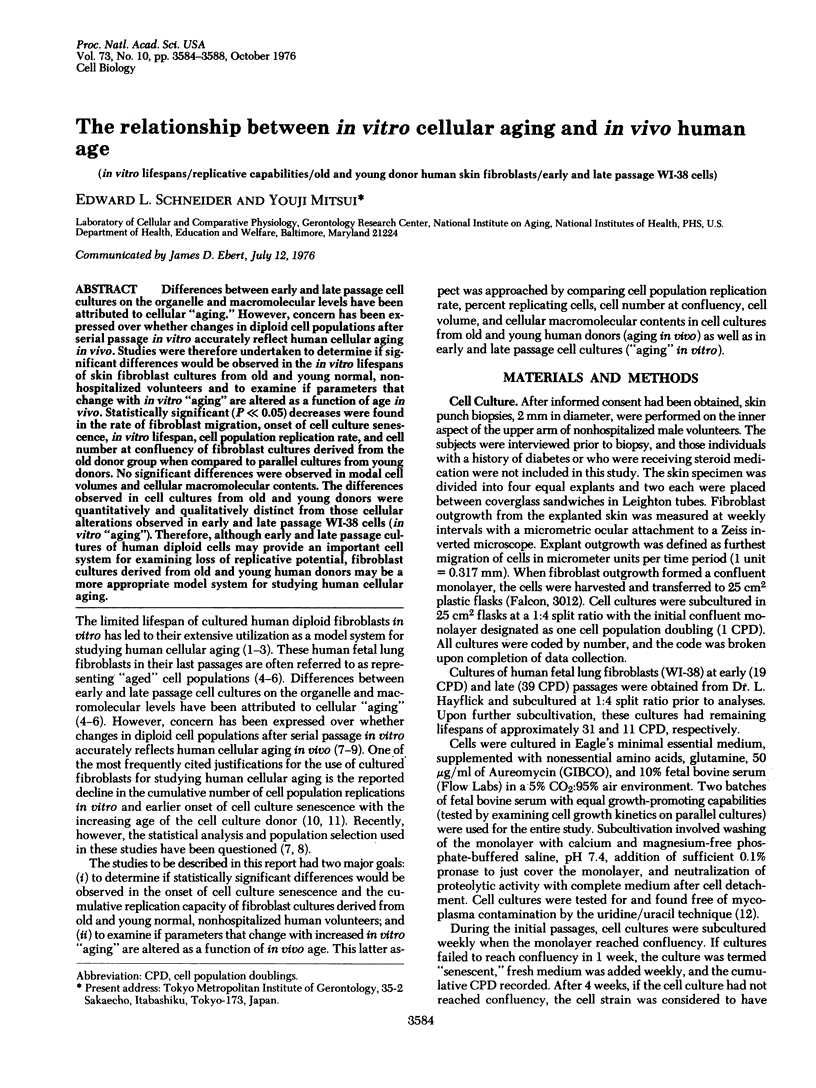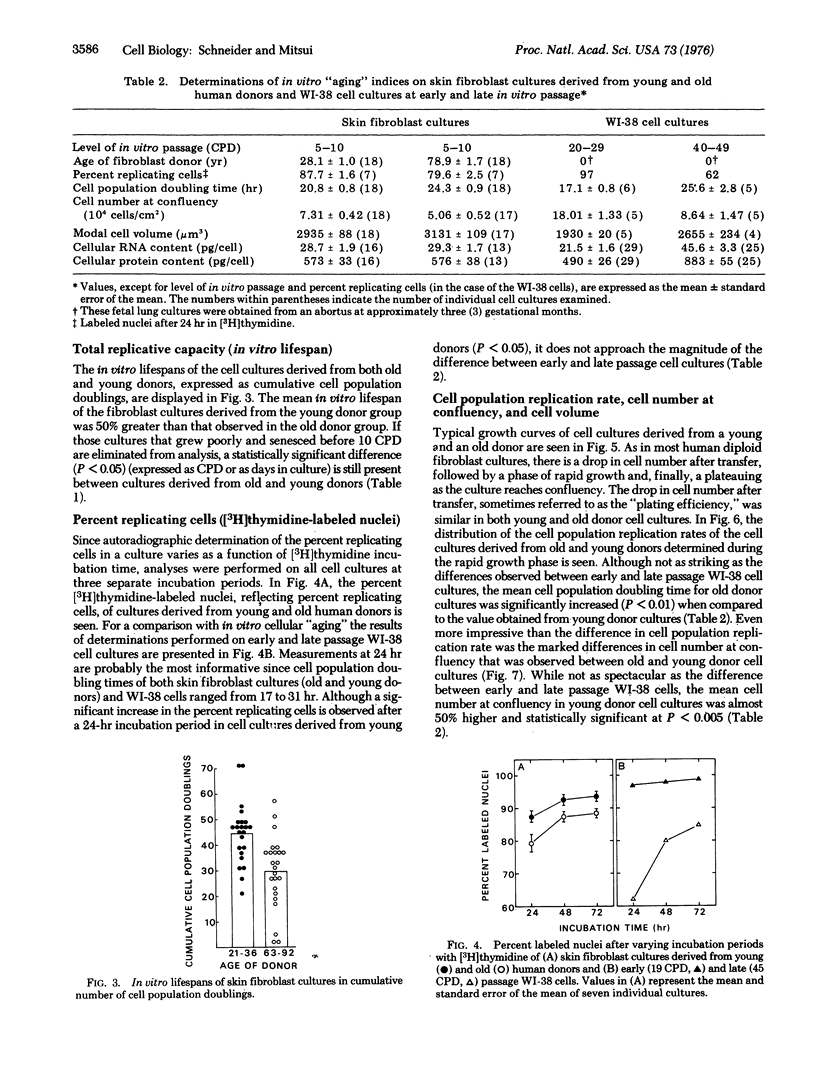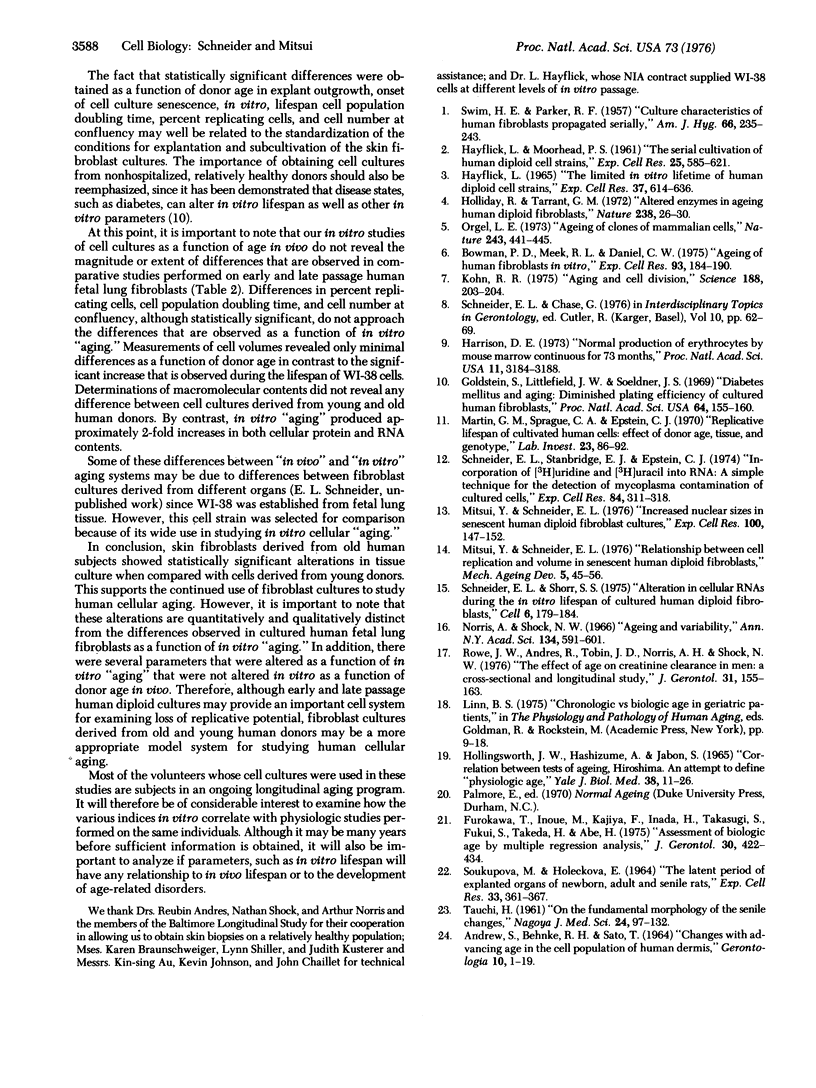Abstract
Differences between early and late passage cell cultures on the organelle and macromolecular levels have been attributed to cellular "aging". However, concern has been expressed over whether changes in diploid cell populations after serial passage in vitro accurately reflect human cellular aging in vivo. Studies were therefore undertaken to determine if significant differences would be observed in the in vitro lifespans of skin fibroblast cultures from old and young normal, non-hospitalized volunteers and to examine if parameters that change with in vitro "aging" are altered as a function of age in vivo. Statistically signigificant (P less than 0.05) decreases were found in the rate of fibroblast migration, onset of cell culture senescence, in vitro lifespan, cell population replication rate, and cell number at confluency of fibroblast cultures derived from the old donor group when compared to parallel cultures from young donors. No significant differences were observed in modal cell volumes and cellular macromolecular contents. The differences observed in cell cultures from old and young donors were quantitatively and qualitatively distinct from those cellular alterations observed in early and late passage WI-38 cells (in vitro "aging"). Therefore, although early and late passage cultures of human diploid cells may provide an important cell system for examining loss of replicative potential, fibroblast cultures derived from old and young human donors may be a more appropriate model system for studying human cellular aging.
Full text
PDF




Selected References
These references are in PubMed. This may not be the complete list of references from this article.
- ANDREW W., BEHNKE R. H., SATO T. CHANGES WITH ADVANCING AGE IN THE CELL POPULATION OF HUMAN DERMIS. Gerontologia. 1964;10:1–19. doi: 10.1159/000211369. [DOI] [PubMed] [Google Scholar]
- Bowman P. D., Meek R. L., Daniel C. W. Aging of human fibroblasts in vitro. Correlations between DNA synthetic ability and cell size. Exp Cell Res. 1975 Jun;93(1):184–190. doi: 10.1016/0014-4827(75)90438-3. [DOI] [PubMed] [Google Scholar]
- Furukawa T., Inoue M., Kajiya F., Inada H., Takasugi S. Assessment of biological age by multiple regression analysis. J Gerontol. 1975 Jul;30(4):422–434. doi: 10.1093/geronj/30.4.422. [DOI] [PubMed] [Google Scholar]
- Goldstein S., Littlefield J. W., Soeldner J. S. Diabetes mellitus and aging: diminished planting efficiency of cultured human fibroblasts. Proc Natl Acad Sci U S A. 1969 Sep;64(1):155–160. doi: 10.1073/pnas.64.1.155. [DOI] [PMC free article] [PubMed] [Google Scholar]
- HAYFLICK L., MOORHEAD P. S. The serial cultivation of human diploid cell strains. Exp Cell Res. 1961 Dec;25:585–621. doi: 10.1016/0014-4827(61)90192-6. [DOI] [PubMed] [Google Scholar]
- HAYFLICK L. THE LIMITED IN VITRO LIFETIME OF HUMAN DIPLOID CELL STRAINS. Exp Cell Res. 1965 Mar;37:614–636. doi: 10.1016/0014-4827(65)90211-9. [DOI] [PubMed] [Google Scholar]
- Harrison D. E. Normal production of erythrocytes by mouse marrow continuous for 73 months. Proc Natl Acad Sci U S A. 1973 Nov;70(11):3184–3188. doi: 10.1073/pnas.70.11.3184. [DOI] [PMC free article] [PubMed] [Google Scholar]
- Holliday R., Tarrant G. M. Altered enzymes in ageing human fibroblasts. Nature. 1972 Jul 7;238(5358):26–30. doi: 10.1038/238026a0. [DOI] [PubMed] [Google Scholar]
- Hollingsworth J. W., Hashizume A., Jablon S. Correlations between tests of aging in Hiroshima subjects--an attempt to define "physiologic age". Yale J Biol Med. 1965 Aug;38(1):11–26. [PMC free article] [PubMed] [Google Scholar]
- Kohn R. R. Aging and cell division. Science. 1975 Apr 18;188(4185):203–204. doi: 10.1126/science.188.4185.203-b. [DOI] [PubMed] [Google Scholar]
- Martin G. M., Sprague C. A., Epstein C. J. Replicative life-span of cultivated human cells. Effects of donor's age, tissue, and genotype. Lab Invest. 1970 Jul;23(1):86–92. [PubMed] [Google Scholar]
- Mitsui Y., Schneider E. L. Increased nuclear sizes in senescent human diploid fibroblast cultures. Exp Cell Res. 1976 Jun;100(1):147–152. doi: 10.1016/0014-4827(76)90336-0. [DOI] [PubMed] [Google Scholar]
- Mitsui Y., Schneider E. L. Relationship between cell replication and volume in senescent human diploid fibroblasts. Mech Ageing Dev. 1976 Jan-Feb;5(1):45–56. doi: 10.1016/0047-6374(76)90007-5. [DOI] [PubMed] [Google Scholar]
- Orgel L. E. Ageing of clones of mammalian cells. Nature. 1973 Jun 22;243(5408):441–445. doi: 10.1038/243441a0. [DOI] [PubMed] [Google Scholar]
- Rowe J. W., Andres R., Tobin J. D., Norris A. H., Shock N. W. The effect of age on creatinine clearance in men: a cross-sectional and longitudinal study. J Gerontol. 1976 Mar;31(2):155–163. doi: 10.1093/geronj/31.2.155. [DOI] [PubMed] [Google Scholar]
- SOUKUPOVA M., HOLECKOVA E. THE LATENT PERIOD OF EXPLANTED ORGANS OF NEWBORN, ADULT AND SENILE RATS. Exp Cell Res. 1964 Feb;33:361–367. doi: 10.1016/0014-4827(64)90001-1. [DOI] [PubMed] [Google Scholar]
- SWIM H. E., PARKER R. F. Culture characteristics of human fibroblasts propagated serially. Am J Hyg. 1957 Sep;66(2):235–243. doi: 10.1093/oxfordjournals.aje.a119897. [DOI] [PubMed] [Google Scholar]
- Schneider E. L., Shorr S. S. Alteration in cellular RNAs during the in vitro lifespan of cultured human diploid fibroblasts. Cell. 1975 Oct;6(2):179–184. doi: 10.1016/0092-8674(75)90008-2. [DOI] [PubMed] [Google Scholar]
- Schneider E. L., Stanbridge E. J., Epstein C. J. Incorporation of 3H-uridine and 3H-uracil into RNA: a simple technique for the detection of mycoplasma contamination of cultured cells. Exp Cell Res. 1974 Mar 15;84(1):311–318. doi: 10.1016/0014-4827(74)90411-x. [DOI] [PubMed] [Google Scholar]
- TAUCHI H. On the fundamental morphology of the senile changes. Nagoya J Med Sci. 1961 Oct;24:97–132. [PubMed] [Google Scholar]


